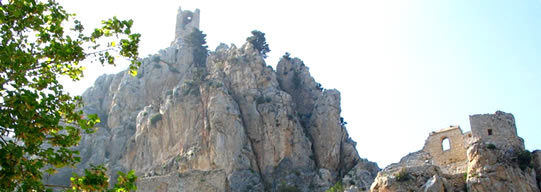
Buffavento castle was built, along with St. Hilarion and Kantara, as a part of the defensive chain against the Arab raids. It is the highest of the three castles, its summit being some 950m above sea level. Like the other two it guarded an important pass through the mountains and it had signal connections with the other two strongholds. When Richard the Lion Heart conquered Cyprus in 1191, the Byzantine despot king of the island Isaac Comnenus is said to have fled there.
Like the other castles of the island it is associated with a mysterious queen, who once ruled Cyprus, a story probably connected with the goddess Aphrodite. One of the popular stories about the castle is that during the reign of the Knight Templars a Byzantine princess noticed that the skin of her dog had begun to heal. Following him she saw that the animal bathed in a spring far below the castle. Doing the same, she was cured. In gratitude, at the spot near the water source she founded the Monastery of Ayios Ioannis Chrysostomos.
“Buffavento”
No wonder it’s name, Buffavento, means “Gusty Winds”, although some prefer the more romantic translation of “Defiant of Winds”! Its lower section begins with an arched gateway. The group of rooms beyond this entrance must have served as barracks and store rooms. Under the rooms a cistern is located. The door and the arches of some rooms in the upper castle show Byzantine style red brickwork. In the upper castle the remains of a chapel can be distinguished. This part offers a staggering view of Nicosia and the Troodos chain in the south.
The lowest part of the castle was probably built by the Byzantines in the 11th century. This base was expanded upon by the Lusignans in the 14th century. It is not regular in shape as it makes use of the mountain itself for its defense. During the Venetian control of the island, Buffavento fell into disuse as the coastal castles of Cyprus, such as Kyrenia and Famagusta, were seen as more important.
Buffavento Castle is on two levels. Walk through the lower arched entrance and you’ll see store-rooms and dormitories opposite, with a water cistern underneath. Take the stairs up from the gatehouse and a ten minute climb will bring you to the top level, with magnificent views, in the right weather conditions, of Kyrenia, Nicosia and Famagusta in North Cyprus, and even the Troodos Mountains in the south. The remains of a small chapel can also been seen here on the upper level.
Buffavento Castle and Richard the Lionheart
Buffavento Castle had various uses over the years. It probably originated as a Byzanine watch-tower, guarding against Arab raiders, and it is said that the Byzantine king Isaac Comnenus fled here when Richard the Lionheart invaded in 1191. The castle surrendered, and during the Lusignan period, Buffavento Castle was used as a prison, known as the ‘Chateau du Lion’. Buffavento Castle then fell into disuse during the Venetian period, as coastal defences became preferable over mountaintop castles. The castle narrowly missed destruction during the disastrous North Cyprus fire of 1995, which destroyed 16,000 acres of forest around the castle site itself. Today, Buffavento is the least preserved of the three castles, but all the more atmospheric and rugged for it.
The best views in North Cyprus.
The Lion Castle
Once known as the Lion Castle in Medieval times, the Buffavento Castle has been used for everything from a watchtower to a political prison, and the walls and ruins of the castle certainly have many stories to tell. You will be able to explore both the lower ward and the upper ward of the Buffavento Castle, and when you explore the castle from its highest point on the upper ward you can look forward to some incredible views. This is a fascinating historical attraction, and is a must for any itinerary if you are spending time in Kyrenia.
Visiting Buffavento Castle, Northern Cyprus
Opening hours for the castle do vary, as the Turkish Army control entry days. If you turn down the track to the castle from the Bufavento Besparmak restaurant and the metal barrier is down, the castle is closed. Walking to the castle from the parking area takes around 20 minutes, and you pass a moving memorial to the victims of a light aircraft crash here in 1988.



